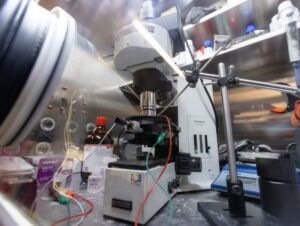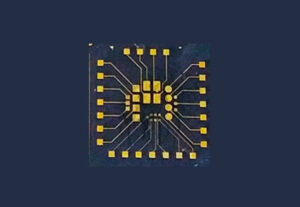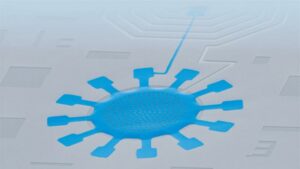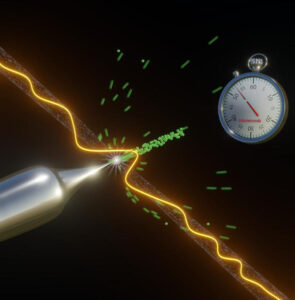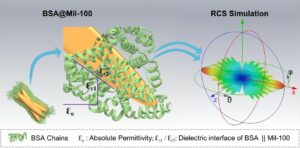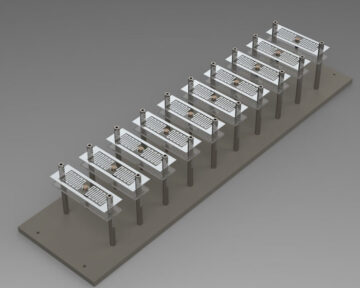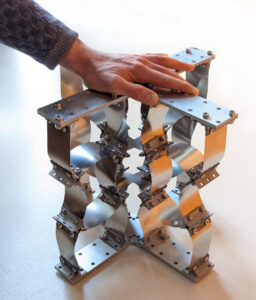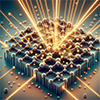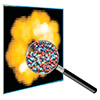11. mai 2023 (Nanowerki uudised) For two decades, physicists have tried to directly manipulate the spin of electrons in 2D materials like graphene. Doing so could spark key advances in the burgeoning world of 2D electronics, a field where super-fast, small and flexible electronic devices carry out computations based on quantum mechanics.
Standing in the way is that the typical way in which scientists measure the spin of electrons — an essential behavior that gives everything in the physical universe its structure — usually doesn’t work in 2D materjalid. This makes it incredibly difficult to fully understand the materials and propel forward technological advances based on them. But a team of scientists led by Brown University researchers believe they now have a way around this longstanding challenge. They describe their solution in a new study published in Loodusfüüsika (“Dirac revivals drive a resonance response in twisted bilayer graphene”).
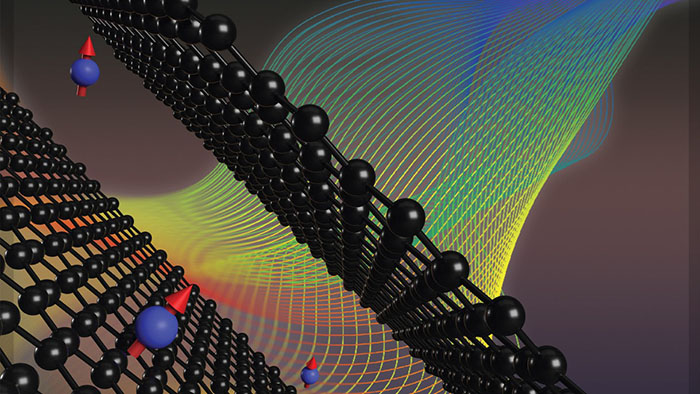 In the study, researchers describe what they believe to be the first measurement showing direct interaction between electrons spinning in a 2D material and photons coming from microwave radiation. (Image: Jia Li, Brown University)
In the study, the team — which also include scientists from the Center for Integrated Nanotechnologies at Sandia National Laboratories, and the University of Innsbruck — describe what they believe to be the first measurement showing direct interaction between electrons spinning in a 2D material and photons coming from microwave radiation. Called a coupling, the absorption of microwave photons by electrons establishes a novel experimental technique for directly studying the properties of how electrons spin in these 2D quantum materials — one that could serve as a foundation for developing computational and communicational technologies based on those materials, according to the researchers.
“Spin structure is the most important part of a quantum phenomenon, but we’ve never really had a direct probe for it in these 2D materials,” said Jia Li, an assistant professor of physics at Brown and senior author of the research. “That challenge has prevented us from theoretically studying spin in these fascinating material for the last two decades. We can now use this method to study a lot of different systems that we could not study before.”
The researchers made the measurements on a relatively new 2D material called “magic-angle” twisted bilayer graphene. This graphene-based material is created when two sheets of ultrathin layers of carbon are stacked and twisted to just the right angle, converting the new double-layered structure into a superconductor that allows electricity to flow without resistance or energy waste. Just discovered in 2018, the researchers focused on the material because of the potential and mystery surrounding it.
"Paljudele 2018. aastal püstitatud peamistele küsimustele pole veel vastust," ütles tööd juhtinud Browni Li labori magistrant Erin Morissette.
Physicists usually use nuclear magnetic resonance or NMR to measure the spin of electrons. They do this by exciting the nuclear magnetic properties in a sample material using microwave radiation and then reading the different signatures this radiation causes to measure spin.
The challenge with 2D materials is that the magnetic signature of electrons in response to the microwave excitation is too small to detect. The research team decided to improvise. Instead of directly detecting the magnetization of the electrons, they measured subtle changes in electronic resistance, which were caused by the changes in magnetization from the radiation using a device fabricated at the Institute for Molecular and Nanoscale Innovation at Brown. These small variations in the flow of the electronic currents allowed the researchers to use the device to detect that the electrons were absorbing the photos from the microwave radiation.
The researchers were able to observe novel information from the experiments. The team noticed, for instance, that interactions between the photons and electrons made electrons in certain sections of the system behave as they would in an anti-ferromagnetic system — meaning the magnetism of some atoms was canceled out by a set of magnetic atoms that are aligned in a reverse direction.
The new method for studying spin in 2D materials and the current findings won’t be applicable to technology today, but the research team sees potential applications the method could lead to in the future. They plan to continue to apply their method to twisted bilayer graphene but also expand it to other 2D material.
"See on tõeliselt mitmekesine tööriistakomplekt, mida saame kasutada nende tugevalt korrelatsiooniga süsteemide elektroonilise tellimuse olulisele osale pääsemiseks ja üldiselt selleks, et mõista, kuidas elektronid võivad 2D-materjalides käituda, " ütles Morissette.
The experiment was carried out remotely in 2021 at the Center for Integrated Nanotechnologies in New Mexico. Mathias S.
In the study, researchers describe what they believe to be the first measurement showing direct interaction between electrons spinning in a 2D material and photons coming from microwave radiation. (Image: Jia Li, Brown University)
In the study, the team — which also include scientists from the Center for Integrated Nanotechnologies at Sandia National Laboratories, and the University of Innsbruck — describe what they believe to be the first measurement showing direct interaction between electrons spinning in a 2D material and photons coming from microwave radiation. Called a coupling, the absorption of microwave photons by electrons establishes a novel experimental technique for directly studying the properties of how electrons spin in these 2D quantum materials — one that could serve as a foundation for developing computational and communicational technologies based on those materials, according to the researchers.
“Spin structure is the most important part of a quantum phenomenon, but we’ve never really had a direct probe for it in these 2D materials,” said Jia Li, an assistant professor of physics at Brown and senior author of the research. “That challenge has prevented us from theoretically studying spin in these fascinating material for the last two decades. We can now use this method to study a lot of different systems that we could not study before.”
The researchers made the measurements on a relatively new 2D material called “magic-angle” twisted bilayer graphene. This graphene-based material is created when two sheets of ultrathin layers of carbon are stacked and twisted to just the right angle, converting the new double-layered structure into a superconductor that allows electricity to flow without resistance or energy waste. Just discovered in 2018, the researchers focused on the material because of the potential and mystery surrounding it.
"Paljudele 2018. aastal püstitatud peamistele küsimustele pole veel vastust," ütles tööd juhtinud Browni Li labori magistrant Erin Morissette.
Physicists usually use nuclear magnetic resonance or NMR to measure the spin of electrons. They do this by exciting the nuclear magnetic properties in a sample material using microwave radiation and then reading the different signatures this radiation causes to measure spin.
The challenge with 2D materials is that the magnetic signature of electrons in response to the microwave excitation is too small to detect. The research team decided to improvise. Instead of directly detecting the magnetization of the electrons, they measured subtle changes in electronic resistance, which were caused by the changes in magnetization from the radiation using a device fabricated at the Institute for Molecular and Nanoscale Innovation at Brown. These small variations in the flow of the electronic currents allowed the researchers to use the device to detect that the electrons were absorbing the photos from the microwave radiation.
The researchers were able to observe novel information from the experiments. The team noticed, for instance, that interactions between the photons and electrons made electrons in certain sections of the system behave as they would in an anti-ferromagnetic system — meaning the magnetism of some atoms was canceled out by a set of magnetic atoms that are aligned in a reverse direction.
The new method for studying spin in 2D materials and the current findings won’t be applicable to technology today, but the research team sees potential applications the method could lead to in the future. They plan to continue to apply their method to twisted bilayer graphene but also expand it to other 2D material.
"See on tõeliselt mitmekesine tööriistakomplekt, mida saame kasutada nende tugevalt korrelatsiooniga süsteemide elektroonilise tellimuse olulisele osale pääsemiseks ja üldiselt selleks, et mõista, kuidas elektronid võivad 2D-materjalides käituda, " ütles Morissette.
The experiment was carried out remotely in 2021 at the Center for Integrated Nanotechnologies in New Mexico. Mathias S.
 In the study, researchers describe what they believe to be the first measurement showing direct interaction between electrons spinning in a 2D material and photons coming from microwave radiation. (Image: Jia Li, Brown University)
In the study, the team — which also include scientists from the Center for Integrated Nanotechnologies at Sandia National Laboratories, and the University of Innsbruck — describe what they believe to be the first measurement showing direct interaction between electrons spinning in a 2D material and photons coming from microwave radiation. Called a coupling, the absorption of microwave photons by electrons establishes a novel experimental technique for directly studying the properties of how electrons spin in these 2D quantum materials — one that could serve as a foundation for developing computational and communicational technologies based on those materials, according to the researchers.
“Spin structure is the most important part of a quantum phenomenon, but we’ve never really had a direct probe for it in these 2D materials,” said Jia Li, an assistant professor of physics at Brown and senior author of the research. “That challenge has prevented us from theoretically studying spin in these fascinating material for the last two decades. We can now use this method to study a lot of different systems that we could not study before.”
The researchers made the measurements on a relatively new 2D material called “magic-angle” twisted bilayer graphene. This graphene-based material is created when two sheets of ultrathin layers of carbon are stacked and twisted to just the right angle, converting the new double-layered structure into a superconductor that allows electricity to flow without resistance or energy waste. Just discovered in 2018, the researchers focused on the material because of the potential and mystery surrounding it.
"Paljudele 2018. aastal püstitatud peamistele küsimustele pole veel vastust," ütles tööd juhtinud Browni Li labori magistrant Erin Morissette.
Physicists usually use nuclear magnetic resonance or NMR to measure the spin of electrons. They do this by exciting the nuclear magnetic properties in a sample material using microwave radiation and then reading the different signatures this radiation causes to measure spin.
The challenge with 2D materials is that the magnetic signature of electrons in response to the microwave excitation is too small to detect. The research team decided to improvise. Instead of directly detecting the magnetization of the electrons, they measured subtle changes in electronic resistance, which were caused by the changes in magnetization from the radiation using a device fabricated at the Institute for Molecular and Nanoscale Innovation at Brown. These small variations in the flow of the electronic currents allowed the researchers to use the device to detect that the electrons were absorbing the photos from the microwave radiation.
The researchers were able to observe novel information from the experiments. The team noticed, for instance, that interactions between the photons and electrons made electrons in certain sections of the system behave as they would in an anti-ferromagnetic system — meaning the magnetism of some atoms was canceled out by a set of magnetic atoms that are aligned in a reverse direction.
The new method for studying spin in 2D materials and the current findings won’t be applicable to technology today, but the research team sees potential applications the method could lead to in the future. They plan to continue to apply their method to twisted bilayer graphene but also expand it to other 2D material.
"See on tõeliselt mitmekesine tööriistakomplekt, mida saame kasutada nende tugevalt korrelatsiooniga süsteemide elektroonilise tellimuse olulisele osale pääsemiseks ja üldiselt selleks, et mõista, kuidas elektronid võivad 2D-materjalides käituda, " ütles Morissette.
The experiment was carried out remotely in 2021 at the Center for Integrated Nanotechnologies in New Mexico. Mathias S.
In the study, researchers describe what they believe to be the first measurement showing direct interaction between electrons spinning in a 2D material and photons coming from microwave radiation. (Image: Jia Li, Brown University)
In the study, the team — which also include scientists from the Center for Integrated Nanotechnologies at Sandia National Laboratories, and the University of Innsbruck — describe what they believe to be the first measurement showing direct interaction between electrons spinning in a 2D material and photons coming from microwave radiation. Called a coupling, the absorption of microwave photons by electrons establishes a novel experimental technique for directly studying the properties of how electrons spin in these 2D quantum materials — one that could serve as a foundation for developing computational and communicational technologies based on those materials, according to the researchers.
“Spin structure is the most important part of a quantum phenomenon, but we’ve never really had a direct probe for it in these 2D materials,” said Jia Li, an assistant professor of physics at Brown and senior author of the research. “That challenge has prevented us from theoretically studying spin in these fascinating material for the last two decades. We can now use this method to study a lot of different systems that we could not study before.”
The researchers made the measurements on a relatively new 2D material called “magic-angle” twisted bilayer graphene. This graphene-based material is created when two sheets of ultrathin layers of carbon are stacked and twisted to just the right angle, converting the new double-layered structure into a superconductor that allows electricity to flow without resistance or energy waste. Just discovered in 2018, the researchers focused on the material because of the potential and mystery surrounding it.
"Paljudele 2018. aastal püstitatud peamistele küsimustele pole veel vastust," ütles tööd juhtinud Browni Li labori magistrant Erin Morissette.
Physicists usually use nuclear magnetic resonance or NMR to measure the spin of electrons. They do this by exciting the nuclear magnetic properties in a sample material using microwave radiation and then reading the different signatures this radiation causes to measure spin.
The challenge with 2D materials is that the magnetic signature of electrons in response to the microwave excitation is too small to detect. The research team decided to improvise. Instead of directly detecting the magnetization of the electrons, they measured subtle changes in electronic resistance, which were caused by the changes in magnetization from the radiation using a device fabricated at the Institute for Molecular and Nanoscale Innovation at Brown. These small variations in the flow of the electronic currents allowed the researchers to use the device to detect that the electrons were absorbing the photos from the microwave radiation.
The researchers were able to observe novel information from the experiments. The team noticed, for instance, that interactions between the photons and electrons made electrons in certain sections of the system behave as they would in an anti-ferromagnetic system — meaning the magnetism of some atoms was canceled out by a set of magnetic atoms that are aligned in a reverse direction.
The new method for studying spin in 2D materials and the current findings won’t be applicable to technology today, but the research team sees potential applications the method could lead to in the future. They plan to continue to apply their method to twisted bilayer graphene but also expand it to other 2D material.
"See on tõeliselt mitmekesine tööriistakomplekt, mida saame kasutada nende tugevalt korrelatsiooniga süsteemide elektroonilise tellimuse olulisele osale pääsemiseks ja üldiselt selleks, et mõista, kuidas elektronid võivad 2D-materjalides käituda, " ütles Morissette.
The experiment was carried out remotely in 2021 at the Center for Integrated Nanotechnologies in New Mexico. Mathias S.
- SEO-põhise sisu ja PR-levi. Võimenduge juba täna.
- PlatoAiStream. Web3 andmete luure. Täiustatud teadmised. Juurdepääs siia.
- Tuleviku rahapaja Adryenn Ashley. Juurdepääs siia.
- Ostke ja müüge IPO-eelsete ettevõtete aktsiaid koos PREIPO®-ga. Juurdepääs siia.
- Allikas: https://www.nanowerk.com/nanotechnology-news2/newsid=62979.php
- :on
- :on
- :mitte
- : kus
- 10
- 11
- 2018
- 2021
- 2D
- 2D materjalid
- 7
- 8
- 9
- a
- Võimalik
- juurdepääs
- Vastavalt
- ettemaksed
- joondatud
- võimaldab
- Ka
- an
- ja
- kohaldatav
- rakendused
- kehtima
- OLEME
- ümber
- AS
- assistent
- At
- autor
- põhineb
- BE
- sest
- enne
- Uskuma
- vahel
- Browni Ülikool
- kuid
- by
- kutsutud
- CAN
- tühistatud
- süsinik
- viima
- põhjustatud
- põhjuste
- keskus
- kindel
- väljakutse
- Vaidluste lahendamine
- tulevad
- arvutused
- jätkama
- konverteeriva
- võiks
- loodud
- Praegune
- kuupäev
- aastakümnete
- otsustatud
- kirjeldama
- arenev
- seade
- seadmed
- erinev
- raske
- otsene
- suund
- otse
- avastasin
- mitu
- do
- Ei tee
- teeme
- ajam
- elekter
- Elektrooniline
- Elektroonika
- elektronid
- energia
- energia raiskamine
- oluline
- kehtestab
- kõik
- põnev
- Laiendama
- eksperiment
- katseid
- lummav
- väli
- järeldused
- esimene
- Esimest korda
- paindlik
- voog
- keskendunud
- eest
- edasi
- Sihtasutus
- Alates
- täielikult
- tulevik
- Üldine
- annab
- koolilõpetaja
- Grafeen
- olnud
- Olema
- Kuidas
- HTTPS
- pilt
- oluline
- in
- sisaldama
- uskumatult
- info
- Innovatsioon
- Näiteks
- selle asemel
- Instituut
- integreeritud
- suhtlemist
- interaktsioonid
- sisse
- IT
- ITS
- jpg
- lihtsalt
- Võti
- labor
- viimane
- kihid
- viima
- Led
- nagu
- Partii
- tehtud
- Magnetism
- peamine
- TEEB
- materjal
- materjalid
- tähendus
- mõõtma
- mõõtmine
- mõõdud
- mehaanika
- meetod
- Mehhiko
- Kesk-
- modelleerimine
- molekulaarne
- kõige
- Mõistatus
- riiklik
- mitte kunagi
- Uus
- romaan
- nüüd
- tuuma-
- jälgima
- of
- on
- ONE
- or
- et
- Muu
- välja
- osa
- nähtus
- Footonid
- Fotod
- PHP
- füüsiline
- Füüsika
- kava
- Platon
- Platoni andmete intelligentsus
- PlatoData
- potentsiaal
- sond
- Õpetaja
- Propell
- omadused
- tingimusel
- avaldatud
- Kvant
- kvantmaterjalid
- Kvantmehaanika
- Küsimused
- Kiirgus
- Lugemine
- tõesti
- suhteliselt
- teadustöö
- Teadlased
- Vastupidavus
- resonants
- vastus
- kaasa
- tagasikäik
- õige
- s
- Ütlesin
- teadlased
- lõigud
- näeb
- vanem
- teenima
- komplekt
- Allkirjad
- väike
- So
- lahendus
- mõned
- Säde
- Spin
- laotud
- Veel
- tugevalt
- struktuur
- õpilane
- Uuring
- Õppimine
- toetama
- ümbritsev
- süsteem
- süsteemid
- meeskond
- tehnoloogiline
- Tehnoloogiad
- Tehnoloogia
- et
- .
- Tulevik
- oma
- Neile
- SIIS
- teoreetiline
- Need
- nad
- see
- need
- aeg
- et
- täna
- liiga
- proovitud
- kaks
- tüüpiline
- mõistma
- mõistmine
- Universum
- Ülikool
- us
- kasutama
- kasutamine
- tavaliselt
- oli
- Jäätmed
- Tee..
- we
- olid
- M
- millal
- mis
- WHO
- koos
- ilma
- Töö
- maailm
- oleks
- veel
- sephyrnet


